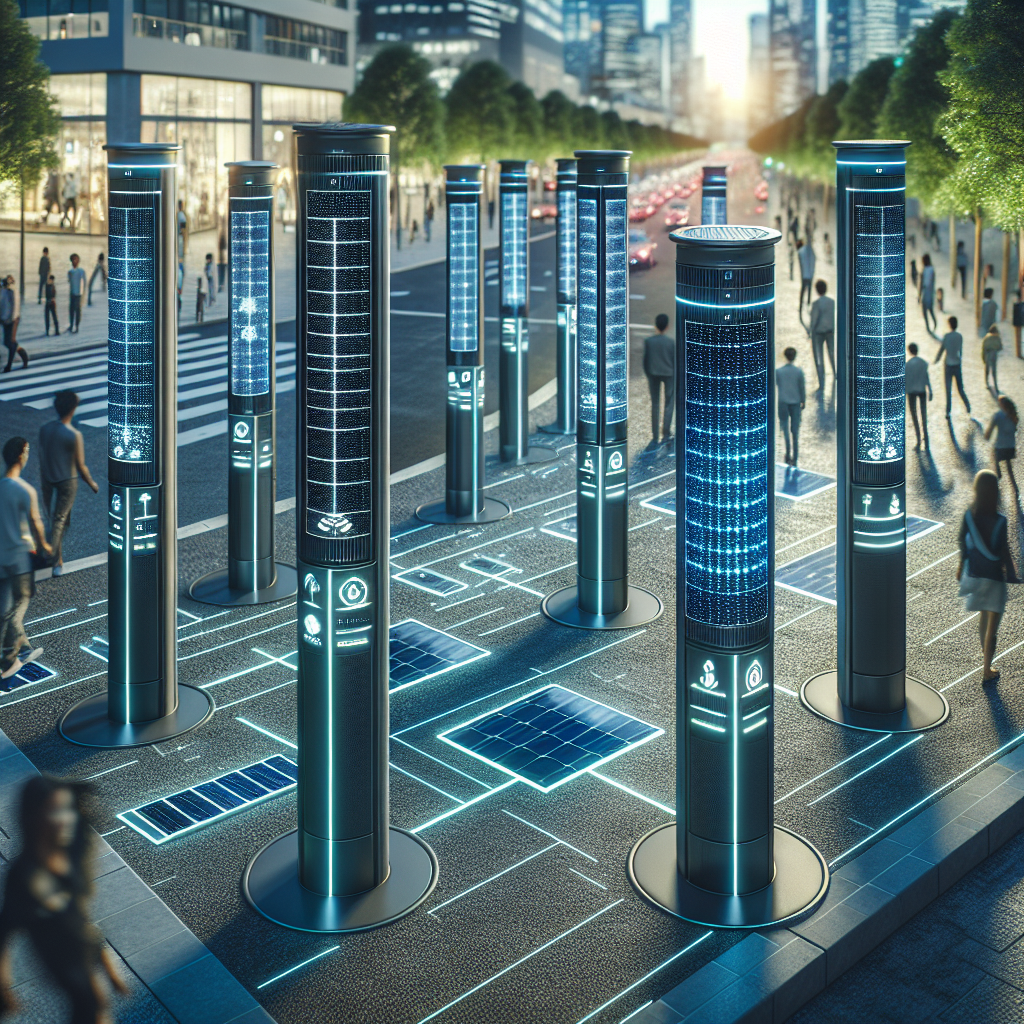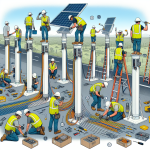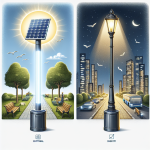Integration of Solar Bollards with Smart Technology
Table of Contents
The integration of solar bollards with smart technology represents a significant advancement in urban infrastructure and sustainable energy solutions. Solar bollards, which are outdoor lighting fixtures powered by solar energy, offer an eco-friendly alternative to traditional electric lighting. By incorporating smart technology, these bollards can be equipped with sensors, connectivity, and automation features that enhance their functionality and efficiency. Smart solar bollards can adjust their brightness based on ambient light conditions, detect motion to provide illumination only when needed, and communicate with central management systems for maintenance and performance monitoring. This integration not only reduces energy consumption and operational costs but also contributes to safer and more adaptive urban environments. As cities strive to become smarter and more sustainable, the deployment of smart solar bollards is poised to play a crucial role in achieving these goals.
Enhancing Urban Infrastructure: The Role of Solar Bollards in Smart Cities
The rapid advancement of technology has significantly transformed urban infrastructure, paving the way for the development of smart cities. Among the various innovations contributing to this transformation, solar bollards have emerged as a pivotal element. These self-sustaining lighting solutions not only enhance the aesthetic appeal of urban landscapes but also play a crucial role in promoting sustainability and energy efficiency. The integration of solar bollards with smart technology further amplifies their benefits, making them indispensable in the quest for smarter, greener cities.
How Do Solar Bollards Work?
Solar bollards, powered by photovoltaic panels, harness solar energy during the day and store it in batteries for use at night. This self-sufficiency eliminates the need for external power sources, reducing both energy consumption and carbon emissions. Moreover, their installation is relatively straightforward, as they do not require extensive wiring or trenching, thereby minimizing disruption to existing infrastructure. However, the true potential of solar bollards is unlocked when they are integrated with smart technology, which enhances their functionality and efficiency.
What Are the Benefits of Integrating Solar Bollards with Smart Technology?
One of the primary advantages of integrating solar bollards with smart technology is the ability to remotely monitor and control their operation. Through the use of sensors and wireless communication, city administrators can gather real-time data on the performance and status of each bollard. This data can be analyzed to identify patterns and trends, enabling proactive maintenance and timely interventions. For instance, if a bollard’s battery is running low or its light output is diminishing, the system can automatically alert maintenance personnel, ensuring that the bollard remains operational and effective.
How Does Adaptive Lighting Work in Smart Solar Bollards?
In addition to remote monitoring, smart technology allows for adaptive lighting, which adjusts the intensity of the bollards based on environmental conditions and human activity. For example, during periods of low pedestrian traffic, the bollards can dim their lights to conserve energy, while brightening up when movement is detected. This dynamic lighting not only enhances safety and security but also optimizes energy usage, contributing to the overall sustainability of the urban environment.
How Do Solar Bollards Integrate with Other Smart City Components?
Furthermore, the integration of solar bollards with smart technology can facilitate the creation of interconnected networks that communicate with other smart city components. For instance, solar bollards can be linked to traffic management systems, enabling them to respond to changes in traffic flow and pedestrian movement. In areas with high foot traffic, the bollards can increase their brightness to improve visibility and safety, while in less frequented areas, they can reduce their output to save energy. This interconnectedness fosters a more responsive and adaptive urban infrastructure, capable of meeting the evolving needs of its inhabitants.
How Can Data from Smart Solar Bollards Inform Urban Planning?
Moreover, the data collected from smart solar bollards can be leveraged to inform urban planning and development. By analyzing patterns of movement and activity, city planners can gain valuable insights into how public spaces are used and identify areas that may require additional lighting or other infrastructure improvements. This data-driven approach ensures that resources are allocated efficiently and that urban development is aligned with the needs and preferences of the community.
What Is the Future of Smart Solar Bollards in Urban Infrastructure?
In conclusion, the integration of solar bollards with smart technology represents a significant advancement in urban infrastructure, offering numerous benefits in terms of sustainability, efficiency, and safety. By harnessing the power of the sun and leveraging cutting-edge technology, smart solar bollards contribute to the creation of more resilient and adaptive cities. As urban areas continue to grow and evolve, the adoption of such innovative solutions will be essential in addressing the challenges of the future and enhancing the quality of life for all residents.
Energy Efficiency and Smart Technology: Integrating Solar Bollards for Sustainable Solutions

The integration of solar bollards with smart technology represents a significant advancement in the pursuit of energy efficiency and sustainable solutions. Solar bollards, which are outdoor lighting fixtures powered by solar energy, have already proven their worth in reducing electricity consumption and minimizing carbon footprints. However, the incorporation of smart technology elevates their functionality, making them an even more compelling choice for urban planners, municipalities, and private enterprises.
How Do Solar Bollards Operate?
To begin with, solar bollards harness the power of the sun to illuminate pathways, parks, and other public spaces. This not only reduces reliance on traditional energy sources but also cuts down on greenhouse gas emissions. The use of photovoltaic panels to capture and convert sunlight into electrical energy ensures that these bollards operate independently of the grid, providing a reliable and renewable source of light. Moreover, the installation of solar bollards is relatively straightforward, requiring minimal trenching and wiring, which further reduces their environmental impact.
What Benefits Does Smart Technology Add to Solar Bollards?
Transitioning to the integration of smart technology, it becomes evident that this combination offers numerous benefits. Smart technology enables solar bollards to be equipped with sensors and connectivity features that enhance their efficiency and functionality. For instance, motion sensors can be installed to detect the presence of pedestrians or vehicles, allowing the bollards to adjust their brightness accordingly. This not only conserves energy but also extends the lifespan of the lighting fixtures. Additionally, smart solar bollards can be programmed to dim or brighten based on the time of day or ambient light conditions, ensuring optimal illumination at all times.
How Does Connectivity Enhance Solar Bollards?
Furthermore, the connectivity aspect of smart technology allows for remote monitoring and control of solar bollards. Through a centralized management system, operators can receive real-time data on the performance and status of each bollard. This facilitates proactive maintenance, as any issues such as battery failures or panel obstructions can be promptly addressed. The ability to remotely control the lighting settings also provides flexibility in adapting to different scenarios, such as special events or emergency situations.
What Role Does Data Collection Play in the Function of Smart Solar Bollards?
Another significant advantage of integrating smart technology with solar bollards is the potential for data collection and analysis. Sensors embedded in the bollards can gather information on foot traffic, weather conditions, and air quality, among other parameters. This data can be invaluable for urban planning and environmental monitoring, offering insights that can inform decision-making processes. For example, understanding pedestrian patterns can help in designing safer and more efficient public spaces, while air quality data can contribute to efforts in combating pollution.
How Do Smart Solar Bollards Align with Sustainability Goals?
In addition to these practical benefits, the integration of solar bollards with smart technology aligns with broader sustainability goals. As cities and communities strive to become more resilient and eco-friendly, the adoption of such innovative solutions demonstrates a commitment to reducing environmental impact and promoting renewable energy. It also sets a precedent for the integration of smart technology in other areas of urban infrastructure, paving the way for smarter, more sustainable cities.
What Is the Future Impact of Smart Solar Bollards?
In conclusion, the integration of solar bollards with smart technology offers a multifaceted approach to enhancing energy efficiency and sustainability. By combining renewable energy with advanced sensors and connectivity features, these smart solar bollards provide reliable, adaptable, and environmentally friendly lighting solutions. As the world continues to grapple with the challenges of climate change and urbanization, such innovations will play a crucial role in shaping a more sustainable future.
Innovations in Public Safety: How Smart Solar Bollards are Transforming Urban Spaces
The integration of solar bollards with smart technology represents a significant advancement in urban infrastructure, offering a multifaceted approach to enhancing public safety. As cities continue to grow and evolve, the need for innovative solutions that address both environmental sustainability and security becomes increasingly paramount. Solar bollards, which are self-sustaining light sources powered by solar energy, have already proven their worth in terms of energy efficiency and reduced carbon footprints. However, the incorporation of smart technology elevates their functionality, making them indispensable assets in modern urban planning.
One of the primary benefits of smart solar bollards is their ability to provide consistent and reliable illumination in public spaces. Traditional street lighting systems often rely on extensive wiring and are susceptible to power outages. In contrast, solar bollards harness energy from the sun, storing it in batteries for use during nighttime hours. This not only ensures continuous lighting but also reduces dependency on the electrical grid, thereby lowering operational costs and minimizing environmental impact. Moreover, the integration of smart technology allows these bollards to adjust their brightness based on ambient light conditions, further optimizing energy consumption.
In addition to their energy efficiency, smart solar bollards contribute significantly to public safety. Equipped with sensors and connectivity features, these bollards can detect motion and adjust their lighting accordingly. For instance, in low-traffic areas, the bollards can dim to conserve energy and then brighten when they sense movement, thereby enhancing visibility and deterring potential criminal activity. This dynamic lighting capability not only improves safety for pedestrians and cyclists but also aids in crime prevention by illuminating areas that might otherwise be shrouded in darkness.
Furthermore, the data collected by smart solar bollards can be invaluable for urban planners and law enforcement agencies. These devices can monitor foot traffic patterns, providing insights into the most frequented areas and times of day. Such information can be used to optimize the placement of additional safety measures, such as surveillance cameras or increased police patrols. Additionally, in the event of an emergency, smart bollards can be programmed to flash or change color, guiding individuals to safety and alerting first responders to the situation.
The integration of smart technology also facilitates remote monitoring and maintenance of solar bollards. Through centralized control systems, city officials can receive real-time updates on the status of each bollard, including battery levels, operational efficiency, and any potential malfunctions. This proactive approach to maintenance ensures that issues are addressed promptly, thereby minimizing downtime and ensuring that public spaces remain well-lit and secure.
Moreover, the aesthetic appeal of solar bollards should not be overlooked. These devices can be designed to complement the architectural style of their surroundings, enhancing the overall visual appeal of urban spaces. The combination of form and function makes smart solar bollards a versatile solution for a variety of settings, from parks and pedestrian pathways to commercial districts and residential neighborhoods.
In conclusion, the integration of solar bollards with smart technology is a transformative development in urban infrastructure. By providing reliable, energy-efficient lighting and enhancing public safety through advanced features, these innovative devices address multiple challenges faced by modern cities. As urban areas continue to expand, the adoption of smart solar bollards will undoubtedly play a crucial role in creating safer, more sustainable, and aesthetically pleasing environments for all residents and visitors.
Read more about Solar Bollards:
- Introduction to Solar Bollards
- How Do Solar Bollards Work?
- Design and Aesthetics of Solar Bollards
- Maintenance and Durability of Solar Bollards
- Applications of Solar Bollards
- Choosing the Right Solar Bollard for Your Needs
- Installation and Wiring of Solar Bollards
- Comparison of Solar Bollards with Traditional Lighting Solutions
- Regulations and Standards for Solar Bollards








